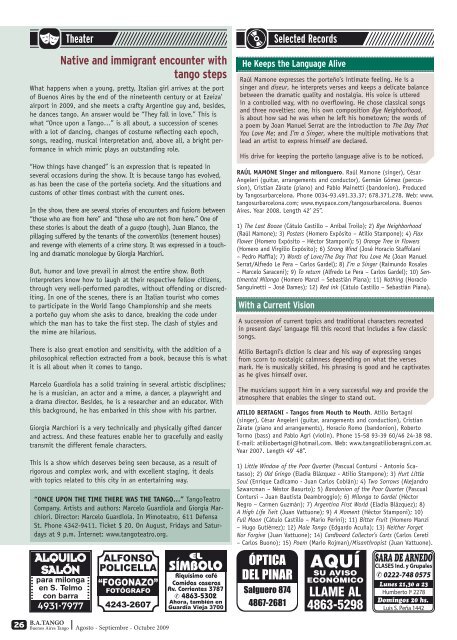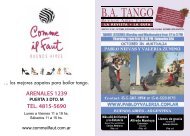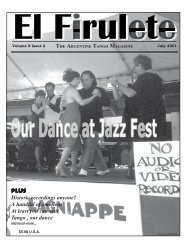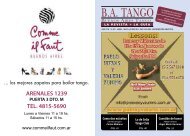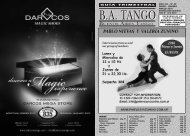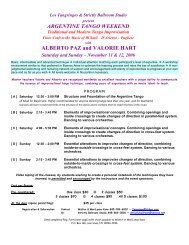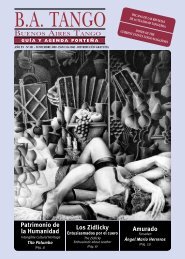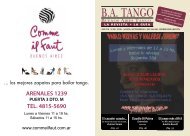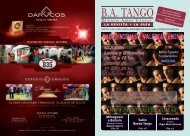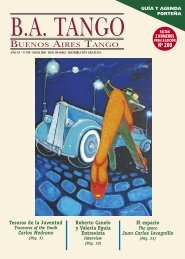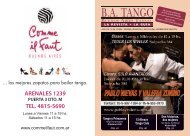La Marshàll x 2 Amistad - Planet Tango
La Marshàll x 2 Amistad - Planet Tango
La Marshàll x 2 Amistad - Planet Tango
Create successful ePaper yourself
Turn your PDF publications into a flip-book with our unique Google optimized e-Paper software.
Native and immigrant encounter with<br />
tango steps<br />
What happens when a young, pretty, Italian girl arrives at the port<br />
of Buenos Aires by the end of the nineteenth century or at Ezeiza’<br />
airport in 2009, and she meets a crafty Argentine guy and, besides,<br />
he dances tango. An answer would be “They fall in love.” This is<br />
what “Once upon a <strong>Tango</strong>…” is all about, a succession of scenes<br />
with a lot of dancing, changes of costume reflecting each epoch,<br />
songs, reading, musical interpretation and, above all, a bright performance<br />
in which mimic plays an outstanding role.<br />
“How things have changed” is an expression that is repeated in<br />
several occasions during the show. It is because tango has evolved,<br />
as has been the case of the porteña society. And the situations and<br />
customs of other times contrast with the current ones.<br />
In the show, there are several stories of encounters and fusions between<br />
“those who are from here” and “those who are not from here.” One of<br />
these stories is about the death of a guapo (tough), Juan Blanco, the<br />
pillaging suffered by the tenants of the conventillos (tenement houses)<br />
and revenge with elements of a crime story. It was expressed in a touching<br />
and dramatic monologue by Giorgia Marchiori.<br />
But, humor and love prevail in almost the entire show. Both<br />
interpreters know how to laugh at their respective fellow citizens,<br />
through very well-performed parodies, without offending or discrediting.<br />
In one of the scenes, there is an Italian tourist who comes<br />
to participate in the World <strong>Tango</strong> Championship and she meets<br />
a porteño guy whom she asks to dance, breaking the code under<br />
which the man has to take the first step. The clash of styles and<br />
the mime are hilarious.<br />
There is also great emotion and sensitivity, with the addition of a<br />
philosophical reflection extracted from a book, because this is what<br />
it is all about when it comes to tango.<br />
Marcelo Guardiola has a solid training in several artistic disciplines;<br />
he is a musician, an actor and a mime, a dancer, a playwright and<br />
a drama director. Besides, he is a researcher and an educator. With<br />
this background, he has embarked in this show with his partner.<br />
Giorgia Marchiori is a very technically and physically gifted dancer<br />
and actress. And these features enable her to gracefully and easily<br />
transmit the different female characters.<br />
This is a show which deserves being seen because, as a result of<br />
rigorous and complex work, and with excellent staging, it deals<br />
with topics related to this city in an entertaining way.<br />
“ONCE UPON THE TIME THERE WAS THE TANGO…” <strong>Tango</strong>Teatro<br />
Company. Artists and authors: Marcelo Guardiola and Giorgia Marchiori.<br />
Director: Marcelo Guardiola. In Mimoteatro, 611 Defensa<br />
St. Phone 4342-9411. Ticket $ 20. On August, Fridays and Saturdays<br />
at 9 p.m. Internet: www.tangoteatro.org.<br />
26 B.A.TANGO<br />
Buenos Aires <strong>Tango</strong><br />
Theater<br />
Agosto - Septiembre - Octubre 2009<br />
Selected Records<br />
He Keeps the <strong>La</strong>nguage Alive<br />
Raúl Mamone expresses the porteño’s intimate feeling. He is a<br />
singer and diseur, he interprets verses and keeps a delicate balance<br />
between the dramatic quality and nostalgia. His voice is uttered<br />
in a controlled way, with no overflowing. He chose classical songs<br />
and three novelties: one, his own composition Bye Neighborhood,<br />
is about how sad he was when he left his hometown; the words of<br />
a poem by Joan Manuel Serrat are the introduction to The Day That<br />
You Love Me; and I’m a Singer, where the multiple motivations that<br />
lead an artist to express himself are declared.<br />
His drive for keeping the porteño language alive is to be noticed.<br />
RAÚL MAMONE Singer and milonguero. Raúl Mamone (singer), César<br />
Angeleri (guitar, arrangements and conductor), Germán Gómez (percussion),<br />
Cristian Zárate (piano) and Pablo Mainetti (bandonion). Produced<br />
by <strong>Tango</strong>surbarcelona. Phone 0034-93.491.33.37; 678.371.278. Web: www.<br />
tangosurbarcelona.com; www.myspace.com/tangosurbarcelona. Buenos<br />
Aires. Year 2008. Length 42’ 25”.<br />
1) The <strong>La</strong>st Booze (Cátulo Castillo – Aníbal Troilo); 2) Bye Neighborhood<br />
(Raúl Mamone); 3) Posters (Homero Expósito – Atilio Stampone); 4) Flax<br />
Flower (Homero Expósito – Héctor Stamponi); 5) Orange Tree in Flowers<br />
(Homero and Virgilio Expósito); 6) Strong Wind (José Horacio Staffolani<br />
– Pedro Maffia); 7) Words of Love/The Day That You Love Me (Joan Manuel<br />
Serrat/Alfredo Le Pera – Carlos Gardel); 8) I’m a Singer (Raimundo Rosales<br />
– Marcelo Saraceni); 9) To return (Alfredo Le Pera – Carlos Gardel); 10) Sentimental<br />
Milonga (Homero Manzi – Sebastián Piana); 11) Nothing (Horacio<br />
Sanguinetti – José Dames); 12) Red ink (Cátulo Castillo – Sebastián Piana).<br />
With a Current Vision<br />
A succession of current topics and traditional characters recreated<br />
in present days’ language fill this record that includes a few classic<br />
songs.<br />
Atilio Bertagni’s diction is clear and his way of expressing ranges<br />
from scorn to nostalgic calmness depending on what the verses<br />
mark. He is musically skilled, his phrasing is good and he captivates<br />
as he gives himself over.<br />
The musicians support him in a very successful way and provide the<br />
atmosphere that enables the singer to stand out.<br />
ATILIO BERTAGNI - <strong>Tango</strong>s from Mouth to Mouth. Atilio Bertagni<br />
(singer), César Angeleri (guitar, arangements and conduction), Cristian<br />
Zárate (piano and arrangements), Horacio Romo (bandonion), Roberto<br />
Tormo (bass) and Pablo Agri (violin). Phone 15-58 93-39 60/46 24-38 98.<br />
E-mail: atiliobertagni@hotmail.com. Web: www.tangoatilioberagni.com.ar.<br />
Year 2007. Length 49’ 48”.<br />
1) Little Window of the Poor Quarter (Pascual Contursi - Antonio Scatasso);<br />
2) Old Gringo (Eladia Blázquez - Atilio Stampone); 3) Hurt Little<br />
Soul (Enrique Cadícamo - Juan Carlos Cobián); 4) Two Sorrows (Alejandro<br />
Szwarcman – Néstor Basurto); 5) Bandonion of the Poor Quarter (Pascual<br />
Contursi – Juan Bautista Deambroggio); 6) Milonga to Gardel (Héctor<br />
Negro – Carmen Guzmán); 7) Argentina First World (Eladia Blázquez); 8)<br />
A High Life Twit (Juan Vattuone); 9) A Moment (Héctor Stamponi); 10)<br />
Full Moon (Cátulo Castillo – Mario Perini); 11) Bitter Fruit (Homero Manzi<br />
– Hugo Gutiérrez); 12) Male <strong>Tango</strong> (Edgardo Acuña); 13) Neither Forget<br />
Nor Forgive (Juan Vattuone); 14) Cardboard Collector’s Carts (Carlos Cereti<br />
– Carlos Buono); 15) Poem (Mario Rojman)/Misanthropist (Juan Vattuone).


